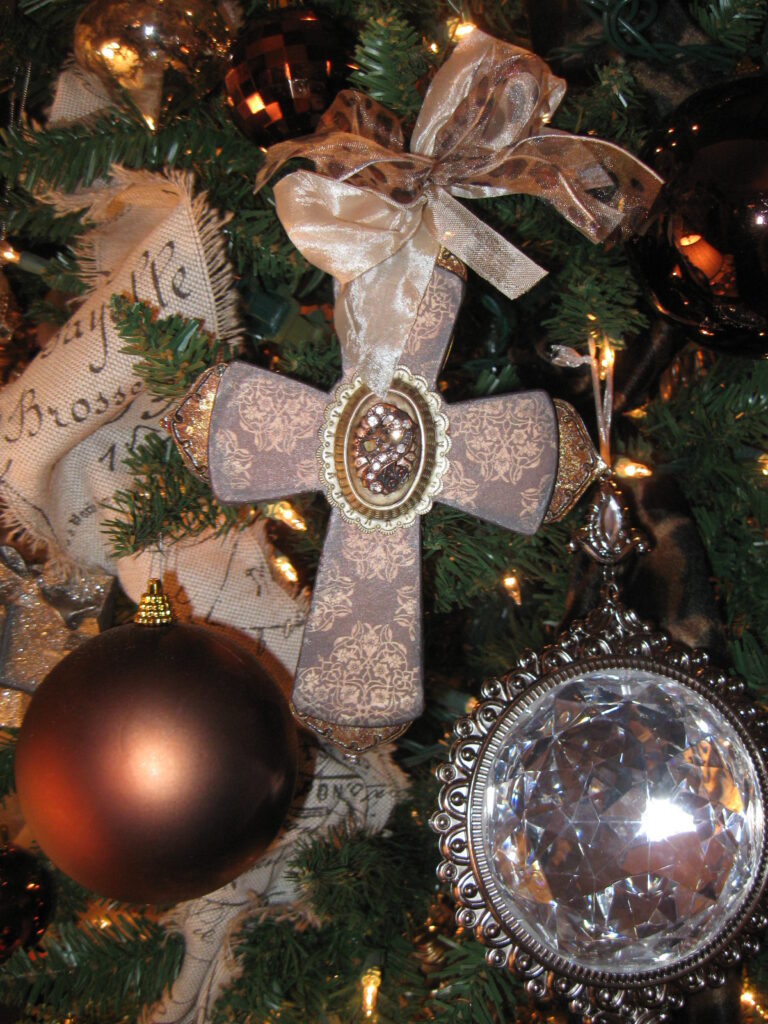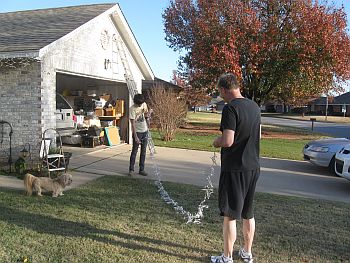
When our family puts up the tree each Christmas, I always envision a Rockwellesque family affair, complete with carols, cocoa and cookies. But what usually happens feels more like a testosterone induced Bah Humbug fest than something out of a Norman Rockwell scene.
Something in the Johnson male species induces seasonal allergic reactions to decorating. Even though I try to convince my husband and 17-year-old adult (?) son that artificial trees do not pollinate, when it’s time to deck the halls, a sudden onslaught of flu-like symptoms begin in John and Garrett—sneezing, puffy eyes and body fatigue. Apparently, I suffer from temporary insanity and nostalgic memory loss, but with my idealistic insistence, some traditions die hard. When I put our tree up this year, I arranged to have the whole family together to help.
It’s the tradition that counts.
Before you get too impressed with my ability to enlist cooperation from family members with steroid hormones, let me clarify exactly what I mean by “help.”
The day before our decorating extravaganza, I hauled out the tree and fifty ornament boxes from the shed. I erected the “easy-to-assemble hinged” Green River Spruce and unmashed each evergreen sprig on the 6,593 tips. How else was I going to get the “fresh-from-the-forest appearance” that the box boasted of? Once the tree was suitably erect and plugged in, I spent three hours with a magnifying glass to find that single wretched burnt-out bulb. Only after the ribbon was strategically woven throughout the branches and I bandaged my arms from all the scratches was it time for the troops to come in and “help.”
“The girls are coming over in a bit,” I told John and Garrett. “We’re going to spend some family time together decorating the tree.”
I could see the excitement oozing from their pores. “Ten ornaments, guys. That’s all you have to hang,” I bribed.
It’s the tradition that counts.
The next morning I cozied up in my favorite chair with my morning coffee and Bible. As I gazed at my twinkling tree, a wave of satisfaction warmed me. Unfortunately, the chestnuts-roasting-on-the-open-fire aura didn’t last long, because that’s when it hit me—the mantle was naked and the porch was bare. I still had work to do.
Open that Bible first.
My spirit wrestled with my decorating-to-do list.
Fighting distraction, I randomly opened my Bible to page 1213 and pointed at a verse in the middle of the page. Sometimes this elementary “point and shoot” method of scripture search I call Bible Roulette works fairly well. Other times, not so much. But today’s verse read,
In that day the Lord Almighty will be a glorious crown, a beautiful wreath for the remnant of his people (Is 28:5).
Occasionally, I read over scripture without giving thought to why certain words are used, but it was hard to ignore the usage of “wreath” at a time when I was distracted by Christmas decorating. Why would God want to be a wreath to me?
By now the word nerd in me was on high alert and I ran to my computer to do a little research. In case you are interested, here’s what I discovered:
· In Rome, laurel crowns were bestowed as a mark of honor, especially on civil officials and returning warriors.
· Originally, the wreath or circlet was called a “diadem” and took the form of fabric headbands which were sometimes adorned with jewels.
· The King James Version of Isaiah 28:5 uses the word “diadem” instead of “wreath”.
· In Hebrew, the phrase “diadem of beauty” translates tsĕphiyrah tiph’arah, which means a chaplet, wreath or crown representing rank, renown, splendor, honor and glory.
· In ancient Greece, wreaths were awarded to athletes victorious in the Olympic Games and as prizes to poets and orators. It is supposed the contestants took their wreaths home and hung them on a door or wall as souvenirs.
· Young lovers in ancient Greece hung wreaths on their lovers’ doorways as a sign of affection.
· In Victorian England, a floral wreath sometimes surrounded the chair of the guest of honor at a banquet.
When I hung my wreath later that day, I pondered the meaning behind the tradition. How often had my holiday rituals lost significance in familiarity? How many times had I done things out of habit and custom and never stopped to question the origin?
As I tied ribbon on my wreath, I realized Christ, the lover of my soul, has a diadem of His glory for me. Just like young lovers in ancient Greece hung wreaths on their lovers’ doorways as a sign of affection, Christ wants to display His crown of beauty on the doorway of my heart so others can see His love for me and desire it for themselves.
I stood back for a moment to admire my new wreath. The metallic ribbon sparkled in the sunlight, but still…it needed a little more splendor, a bit more bling. I rummaged through my ornament boxes and there it was…the perfect centerpiece—a jewel encrusted crown. As I secured the crown in place, I finally understood. It’s not the tradition that counts.
It’s the meaning that matters.
 By the way. Even though John and Garrett suffer from seasonal decorating allergies, I think they really do like Christmas festivities. Like real men often do, they’d just rather take it outside.
By the way. Even though John and Garrett suffer from seasonal decorating allergies, I think they really do like Christmas festivities. Like real men often do, they’d just rather take it outside.
Prayer: Dear Lord, I pray I never forget that You are my wreath of hope and my garland of splendor! You bring hope and victory for the world. May I always be aware that the world needs to see Your glory in me. In Christ’s name I pray. Amen.
Scriptures to Ponder:
· He (King Solomon) engraved cherubim, lions and palm trees on the surfaces of the supports and on the panels, in every available space, with wreaths all around (1 Kings 7:36).
· The nations will see your righteousness, and all kings your glory; you will be called by a new name that the mouth of the LORD will bestow. You will be a crown of splendor in the Lord’s hand, a royal diadem in the hand of your God (Isaiah 62:2-3).
· But you are a chosen people, a royal priesthood, a holy nation, a people belonging to God, that you may declare the praises of him who called you out of darkness into his wonderful light (1 Peter 2:9).
Questions to Ponder:
1. What are your favorite Christmas traditions and why?
2. Do you know the meaning or origin of your favorite traditions? If so, explain.
3. Read 1 Kings 7:36 above. Why do you think the palace décor was described in such great detail?
4. Exodus 29 explains in great detail the way priests were consecrated. Why do you think every article of clothing the priests wore had meaning and purpose?
5. Read 1 Peter 2:9 above. How do you think viewing yourself as a priest would affect your choice in clothing? In appearance? In countenance? Do you see yourself as a priest?
6. Christ was the King of the Jews but Roman soldiers gave him a crown of thorns and mocked before he died. What symbolism do you see in his crown?

Christy,
I have to say you are one of the most gifted writers. Thank you for using it to further the Kingdom of God. I pray your family experiences the sweetness of Jesus during this special time of year.
From My Heart to Yours,
Carla McDougal
Reflective Life Ministries
You do have a way with words young lady!!. Every word & illustration, along with bible verses, always weave so good together. How be fitting it is to expound on a little word like wreath, with such a big meaning, doing such a wonderful & exhilarating time of celebrating our Saviour!!!!!
Have a joyous Christmas,
Love,
Marta
Thanks Christy for your beautiful story. I love the verse in Isa. 28:5 that you randomly chose to read. I had never read that before, but the meaning fits your story, and makes me think of Heaven when Jesus returns for His bride, the church. It’s so true what you said about it’s the meaning behind the tradition that matters. It’s what makes special memories today, and leaves a legacy for others we leave behind. I love your picture at the end of your story, you’re right, as men and women we gravitate towards differents activity.
But what each contributes becomes meaningful for the giver, and a blessing to the receiver. Nina made various shaped small bowls, decorated in a variety of colors and designs for each member of the family. She had made them in her art class at school. I told her that was far more meaningful and precious than anything she could have bought with money.
As I gazed at the bowl she had given me before I went to bed,
somehow the pain of the wrecked car gave way to more love and forgiveness. God uses decorated bowls, or anything He wants to connect us to each other.
Have a blessed Christmas,
Love,
Barb